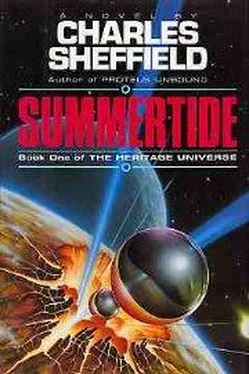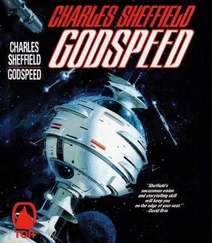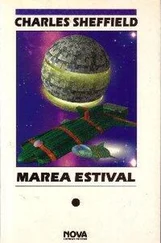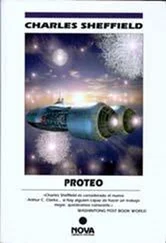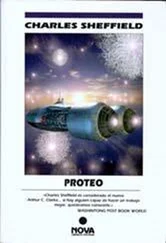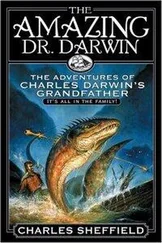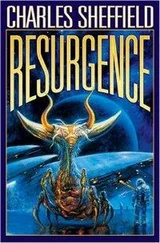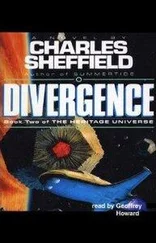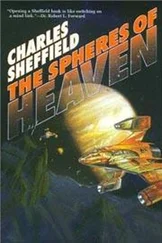And those purposes could not be found out from their creators. Like the planet, the artifact was uninhabited.
Tamara and Damon Savalle found themselves cruising in their pinnace along one of the filaments, a metal-and-polymer tube three kilometers wide and fifty thousand long. Maintenance machines crept along the inner surface, moving so slowly that their motion was hardly perceptible. The machines ignored the little pinnace completely.
Tamara was at the communications panel, in contact with the main ship. “They confirm our analyses of meteorite pitting,” she said. “At least ten million years old, uninhabited for more than three. And I don’t see anything to grin at.”
“Sorry.” Damon did not look it. “I was thinking of the old paradox from before Expansion. If there are aliens, where are they? Twenty days ago we thought we had the answer: no aliens. Now we’re asking it all over again. Where are they, Tammy? Who built all this stuff? And where are the builders?”
She shrugged. Damon’s question would remain unanswered for more than three thousand years.
But while they stared and marveled, a weak incoming signal was reaching the main ship from a small and struggling colony on Eta Cassiopeiae A. It told of an intriguing new physical theory involving Bose-Einstein statistics, along with a suggestion for a subtle and complex deep-space experiment far beyond the limited resources of the little colony.
With everyone at Lacoste focused on the Builders, the new message received no attention at all.
But the Builders were long gone; and superluminal travel was on the way.
ARTIFACT: COCOON
UAC#: 1
Galactic Coordinates: 26,223.489/14,599.029/+112.58
Name: Cocoon Star/planet association: Lacoste/Savalle
Bose Access Node: 99 Estimated age: 10.464 ± 0.41 Megayears
Exploration History: Cocoon holds a special place in human history, as the first artifact to be discovered by human explorers, just as Cusp (see Entry 300) was the first to be discovered by the Cecropian clade. Cocoon was found in E. 1086 by a Crawlspace colony ship seeking habitable planets in the Lacoste system.
Physical Description: The form of Cocoon is a three-dimensional development of the familiar ring cities in place around many inhabited worlds. However, it goes far beyond the standard equatorial-plane assemblies, in both extent and presumed function. This artifact employs forty-eight Basal Stalks connecting Cocoon to the equatorial planetary surface and reaching up to the continuous ring structure at stationary altitude. Four hundred and thirty-two thousand exterior filaments stretch five hundred thousand kilometers from the planet. No two filaments are identical, but typical dimensions of the hollow cylindrical tubes are from two to four kilometers, exterior radius. Viewed from many locations, the surface of Savalle is completely obscured by Cocoon.
The corridors of Cocoon’s interior are extensively patrolled by Phages (see Entry 1067). Explorers must monitor continuously for their presence.
Physical Nature: Construction of Cocoon employs the standard superstrength polymers used in most Builder artifacts. The absence of a second satellite for Savalle, even though the fossil record clearly shows that double-satellite tides occurred until twelve million years ago, suggests a now-vanished moon as the main source of Cocoon’s construction materials.
Cocoon’s filaments are held in stable position by a balance of gravity, rotating reference frames, and stellar radiation pressure. No unfamiliar science is needed to explain that stability, although the system design calls for the solution of large, discrete optimization problems beyond the best computers available within the Clades. Elephant (see Entry 859) was applied to the problem and reached a constrained solution (the so-called Cocoon Restricted Problem) in four standard years of computation time.
Intended Purpose: There are few secrets to Cocoon, if we except the need for such a massive system. The Basal Stalks permit materials to pass to and from the planetary surface of Savalle at negligible cost; the Exterior Filaments allow economical payload transfer to any point of the Lacoste stellar system, using the momentum-bank principle. The capacity of Cocoon is enormous: one fifty-thousandth of the mass of Savalle could in principle be transferred to space each year, enough to slow the planetary rotation rate appreciably and change Savalle’s day by two seconds.
—From the
Lang Universal Artifact Catalog, Fourth Edition.
CHAPTER 1
Expansion
4135 (6219 A.D.)
Where am I?
A man who had seen fifty planets and succeeded in a hundred difficult jobs ought to be like a cat, turning instinctively to land on his feet in any situation. But recently he seemed to be just the opposite, more disoriented with every new task.
Hans Rebka came fully awake and lay with eyes closed, waiting for memory of place and function to seep into his brain. As that came, confusion was replaced by anger.
A week earlier he had been in orbit around Paradox, preparing for one of the most challenging assignments of his life. He and three companions were to enter the Paradox sphere, carrying with them new shielding and a completely new type of recording sensor. If they succeeded they would bring back for the first time information from the Paradox interior — perhaps new information about the Builders themselves.
To Rebka, Paradox was the most enigmatic and intriguing of all Builder structures. The dark, spherical bubble, fifty kilometers across, permitted ready entry but on exit removed all memories, organic or inorganic. Computers emerged with no recording on any storage medium. Humans who had reached the interior returned with the minds of newborn infants.
Exploration efforts had finally been abandoned; but lately visitors to the region of Paradox had been reporting changes. The bubble was different in external appearance, and possibly in internal status. A new effort might succeed.
It was a dangerous mission, but Hans Rebka had been looking forward to it. He had volunteered, and he had been accepted as team leader.
And then the call had come, just one day before the descent into Paradox.
“An alternative assignment…” The voice was thin and whispering, reduced in frequency spectrum by its passage through the Bose communications network. ”… to the double-planet of Dobelle. You must leave without delay…”
The space-thinned voice sounded in no way imperious, but the command emanated from the highest government level of the Phemus Circle. And it was an assignment for Rebka alone; his companions would proceed to explore Paradox. At first it sounded like an honor, a privilege that he should be singled out in that way. But as the assignment was explained to him, Rebka’s confusion began.
He knew his talents. He was a doer and a fixer, and a damned good one. He could think on his feet and improvise solutions in real-time to tough problems; he was a typical product of his home world, Teufel.
“What sins must a man commit, in how many past lives, to be born on Teufel?” Half the spiral arm knew that saying. Like all the planets of the Phemus Circle, Teufel was resource-poor and metal-poor. Settled in despair and dire necessity as the life-support systems of an early colony ship faltered and failed, it was also an outcast planet, too hot, too small, and with a barely breathable atmosphere. The life expectancy of a human who grew to maturity on Teufel — most did not — was less than half the average for the Phemus Circle, and less than a third of that for an inhabitant of any world of the Fourth Alliance. All those born and raised on Teufel found an instinct for self-preservation before they could talk — or they never lasted long enough to talk.
Читать дальше
